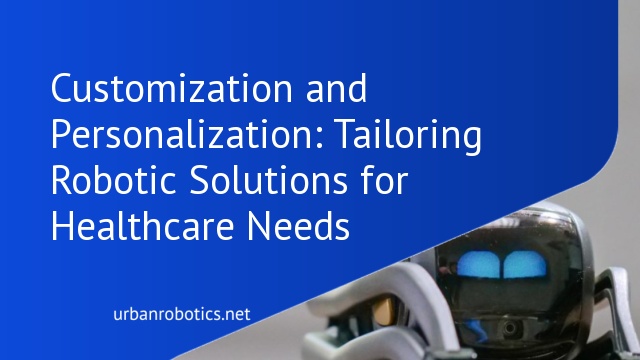Welcome to our article on customizing robotic healthcare solutions to provide personalized patient care using medical robotics. In today’s rapidly evolving healthcare landscape, the integration of ICT-based integrated care solutions offers a potential solution to address the projected worldwide workforce shortfall of healthcare professionals by 2030.
One area that has gained significant attention is the use of assistive robotics to compensate for the shortage of healthcare professionals. These robotic solutions have shown promising results in realistic assistive scenarios, helping to bridge the gap and ensure high-quality patient care.
With the recent COVID-19 pandemic, the integration of social robots in healthcare has become even more evident. These advanced robotic systems, equipped with cognitive and interaction capabilities, play a crucial role in providing personalized and adaptive assistance to patients.
Key to achieving personalized and adaptive assistance is the use of advanced control systems and ontology-based representation. These systems enable robots to assess and administer therapies based on individual needs and preferences, as well as support healthcare professionals in delivering personalized care.
By leveraging profiling procedures and user modeling capabilities based on the International Classification of Functioning, Disability and Health (ICF), robots can effectively personalize their interactions and behaviors. This level of customization ensures that patients receive tailored care that meets their specific healthcare needs.
In the following sections of this article, we will explore the promise of artificial intelligence in healthcare, the advancements in soft robotics for personalized medicine, the historical development of actuators, and the integration of microscale robotics and autologous biomaterials. Together, these technologies shape the future of healthcare, enabling us to provide personalized medical techniques that enhance patient outcomes.
Stay tuned for more in this exciting series on the intersection of robotics and healthcare!
The Promise of Artificial Intelligence in Healthcare
Artificial intelligence (AI) has the potential to revolutionize healthcare by enhancing diagnostics, treatment planning, and personalized patient care. AI-powered systems can analyze vast amounts of medical data, including electronic health records and genomic information, to identify patterns and provide actionable insights. This can improve the accuracy and efficiency of diagnoses, enable more precise treatment plans, and predict patient outcomes. AI can also support fraud and abuse detection, drug development, and personalized cancer care. The integration of AI into healthcare workflows can improve efficiency, reduce costs, and ultimately improve patient outcomes.
The Potential of AI in Diagnostics
One of the primary areas where AI shows promise in healthcare is in diagnostics. By leveraging machine learning algorithms, AI systems can analyze medical images, such as X-rays and MRIs, to detect and classify abnormalities. These AI-powered diagnostic tools have shown comparable or even superior performance to human radiologists in detecting certain conditions, such as lung cancer and diabetic retinopathy. By automating the diagnostic process, AI can help reduce human error, improve the speed of diagnosis, and ensure consistent and accurate results.
Precision Medicine and Treatment Planning
AI can also play a significant role in precision medicine, which focuses on tailoring treatments to individual patients based on their unique genomic and molecular profiles. By analyzing genetic data, AI algorithms can identify specific genetic variants associated with diseases or treatment response, enabling personalized treatment plans. This approach can help healthcare providers optimize drug selection, dosage, and timing, leading to improved treatment outcomes and reduced adverse effects. Additionally, AI can assist in drug discovery and development by analyzing vast datasets and identifying potential drug candidates with higher efficacy and lower toxicity.
Enhancing Patient Care and Outcomes
Beyond diagnostics and treatment planning, AI can enhance patient care and outcomes in various ways. For instance, AI-powered chatbots and virtual assistants can provide 24/7 personalized support to patients, answering their questions, providing medication reminders, and offering emotional support. AI can also monitor patients remotely, collecting physiological data and detecting early signs of deterioration, allowing for timely interventions. Furthermore, AI-powered predictive analytics can help healthcare organizations identify high-risk patients who may require additional interventions or preventive measures, reducing hospital readmissions and improving overall care coordination.
| AI Applications in Healthcare | Benefits |
|---|---|
| Medical Imaging Analysis | – Improved accuracy in diagnosing diseases – Faster and more efficient image interpretation – Consistent results |
| Precision Medicine | – Personalized treatment plans – Optimized drug selection and dosage – Reduced adverse effects |
| Patient Monitoring and Support | – Remote monitoring of vital signs – Timely detection of deteriorating conditions – Personalized virtual support and reminders |
| Predictive Analytics | – Identifying high-risk patients – Proactive interventions and preventive measures – Improved care coordination |
Soft Robotics: Advancing Personalized Medicine in Wearable Technologies
Soft robotics, with their integration of low modulus materials into robotic systems, have opened new possibilities in personalized medicine and wearable technologies. These compliant devices offer numerous biomedical applications, providing biocompatibility, a wide range of motion, material compliance, and tunability. Wearable devices such as gloves and exosuits utilize soft robotics for assistive and rehabilitative purposes, effectively restoring limb and joint function. Additionally, soft robotics find applications in implantable devices, minimally invasive surgery tools, and wearable technologies for continuous health monitoring. The customizable nature of soft robotics enables tailored approaches to monitoring and treating chronic illnesses, serious injuries, cardiovascular diseases, and cancer. Moreover, they provide increased comfort, biocompatibility, and patient compliance in personalized care.
Applications of Soft Robotics in Personalized Medicine
Soft robotics play a crucial role in advancing personalized medicine, particularly in wearable technologies. These technologies offer a range of benefits, including:
- Enhanced rehabilitation and assistive capabilities
- Improved monitoring and diagnostics
- Customizable treatments for chronic illnesses and injuries
- Increased patient comfort and compliance
By leveraging the properties of soft robotics, healthcare professionals can tailor interventions to address individual patient needs and preferences. This personalized approach ensures that patients receive the most effective and comfortable care possible, leading to improved outcomes and quality of life.
Table: Applications of Soft Robotics in Personalized Medicine
| Application | Benefit |
|---|---|
| Assistive and rehabilitative devices | Restore limb and joint function |
| Implantable devices | Enhance treatment precision and effectiveness |
| Minimally invasive surgery tools | Enable precise and less invasive procedures |
| Wearable technologies for continuous health monitoring | Provide real-time data for personalized care |
As soft robotics continue to evolve, they hold great promise for advancing personalized medicine and transforming the way healthcare is delivered. By leveraging their unique capabilities, we can create innovative solutions that improve patient outcomes and enable truly individualized care.
A Historical View of Actuator Development and Applications
In the field of soft robotics, actuator development has seen significant advancements in various mechanisms and technologies over the years. These actuators play a crucial role in enabling the movement and functionality of wearable technologies, such as gloves, exosuits, and rehabilitation devices, which aim to restore limb and joint function in assistive and rehabilitative purposes.
One notable development in actuator technology is the McKibben actuators, which were first introduced in 1958. These actuators utilize a pneumatic system with a rubber bladder and helically wound mesh to enable actuation. They have found applications in wearable technologies, where their flexibility and versatility are highly beneficial.
In 1992, silicone pneumatic actuators emerged as another significant development in actuator technology. These actuators use elastomer materials and pressurized chambers to control bending direction, providing precise and controlled movements. Their compliance and biocompatibility make them suitable for use in wearable technologies for personalized care.
Tendon-based actuation systems have also gained prominence in recent years. These systems combine soft materials with cables driven by servo motors to create contractile movements. They offer a unique combination of flexibility and strength, making them suitable for a range of wearable devices. Tendon-based actuation has been widely utilized in applications such as exoskeletons and rehabilitation devices.
| Actuator Technology | Year Introduced | Applications |
|---|---|---|
| McKibben Actuators | 1958 | Wearable technologies, assistive devices |
| Silicone Pneumatic Actuators | 1992 | Wearable technologies, personalized care |
| Tendon-Based Actuation Systems | N/A | Exoskeletons, rehabilitation devices |
Microscale Robotics and Autologous Biomaterials: Advancing Personalized Medicine
The integration of microscale robotics and autologous biomaterials represents a significant advancement in the field of personalized medicine. By harnessing the power of miniaturized robotic components at the micro and nanoscale, we can create dynamic and functional devices that are tailored to individual patient needs. This innovative approach holds great promise for revolutionizing the way we deliver healthcare.
One of the key advantages of microscale robotics is their ability to deliver personalized medical techniques. These tiny robots can be designed to perform specific tasks within the body, such as targeted drug delivery or precise surgical interventions. By deploying these functional devices, we can enhance the effectiveness of treatments while minimizing potential side effects, leading to improved patient outcomes.
A pivotal aspect of this advancement lies in the use of autologous biomaterials. By incorporating biopolymers and protein-based systems into medical devices, we can leverage the body’s own natural resources to optimize treatment methods. This personalized approach not only increases the efficacy of therapies but also reduces the risk of adverse reactions, as the biomaterials are derived from the patient’s own body.
The combination of microscale robotics and autologous biomaterials has the potential to shape the future of healthcare. By tailoring treatments to the individual, we can achieve better outcomes and improve the overall quality of care. As we continue to explore the possibilities of this exciting field, personalized medicine will undoubtedly become a cornerstone of modern healthcare.





